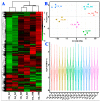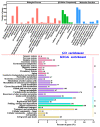Comparative Transcriptomic Analyses Propose the Molecular Regulatory Mechanisms Underlying 1,8-Cineole from Cinnamomum kanehirae Hay and Promote the Asexual Sporulation of Antrodia cinnamomea in Submerged Fermentation
- PMID: 38005233
- PMCID: PMC10672923
- DOI: 10.3390/molecules28227511
Comparative Transcriptomic Analyses Propose the Molecular Regulatory Mechanisms Underlying 1,8-Cineole from Cinnamomum kanehirae Hay and Promote the Asexual Sporulation of Antrodia cinnamomea in Submerged Fermentation
Abstract
Antrodia cinnamomea is a valuable edible and medicinal mushroom with antitumor, hepatoprotective, and antiviral effects that play a role in intestinal flora regulation. Spore-inoculation submerged fermentation has become the most efficient and well-known artificial culture process for A. cinnamomea. In this study, a specific low-molecular compound named 1,8-cineole (cineole) from Cinnamomum kanehirae Hay was first reported to have remarkably promoted the asexual sporulation of A. cinnamomea in submerged fermentation (AcSmF). Then, RNA sequencing, real-time quantitative PCR, and a literature review were performed to predict the molecular regulatory mechanisms underlying the cineole-promoted sporulation of AcSmF. The available evidence supports the hypothesis that after receiving the signal of cineole through cell receptors Wsc1 and Mid2, Pkc1 promoted the expression levels of rlm1 and wetA and facilitated their transfer to the cell wall integrity (CWI) signal pathway, and wetA in turn promoted the sporulation of AcSmF. Moreover, cineole changed the membrane functional state of the A. cinnamomea cell and thus activated the heat stress response by the CWI pathway. Then, heat shock protein 90 and its chaperone Cdc37 promoted the expression of stuA and brlA, thus promoting sporulation of AcSmF. In addition, cineole promoted the expression of areA, flbA, and flbD through the transcription factor NCP1 and inhibited the expression of pkaA through the ammonium permease of MEP, finally promoting the sporulation of AcSmF. This study may improve the efficiency of the inoculum (spores) preparation of AcSmF and thereby enhance the production benefits of A. cinnamomea.
Keywords: 1,8-cineole; Antrodia cinnamome; Cinnamomum kanehirae Hay; asexual sporulation; molecular regulatory mechanism; submerged fermentation; transcriptomics.
Conflict of interest statement
The authors declare no conflict of interest.
Figures







Similar articles
-
Comparative Transcriptomic Analyses Reveal the Regulatory Mechanism of Nutrient Limitation-Induced Sporulation of Antrodia cinnamomea in Submerged Fermentation.Foods. 2022 Sep 5;11(17):2715. doi: 10.3390/foods11172715. Foods. 2022. PMID: 36076898 Free PMC article.
-
Molecular Regulatory Mechanism of the Iron-Ion-Promoted Asexual Sporulation of Antrodia cinnamomea in Submerged Fermentation Revealed by Comparative Transcriptomics.J Fungi (Basel). 2023 Feb 10;9(2):235. doi: 10.3390/jof9020235. J Fungi (Basel). 2023. PMID: 36836349 Free PMC article.
-
Comparative Transcriptomic and Proteomic Analyses Reveal a FluG-Mediated Signaling Pathway Relating to Asexual Sporulation of Antrodia camphorata.Proteomics. 2017 Sep;17(17-18). doi: 10.1002/pmic.201700256. Proteomics. 2017. PMID: 28792668
-
Production of bioactive metabolites by submerged fermentation of the medicinal mushroom Antrodia cinnamomea: recent advances and future development.Crit Rev Biotechnol. 2019 Jun;39(4):541-554. doi: 10.1080/07388551.2019.1577798. Epub 2019 Feb 27. Crit Rev Biotechnol. 2019. PMID: 30810393 Review.
-
Evidence-Based Nutraceuticals Derived from Antrodia cinnamomea.Foods. 2025 Mar 30;14(7):1212. doi: 10.3390/foods14071212. Foods. 2025. PMID: 40238365 Free PMC article. Review.
Cited by
-
Mechanistic and Functional Studies on the Microbial Induction of Wolfiporia cocos Liquid Fermentation Products.Foods. 2024 May 18;13(10):1578. doi: 10.3390/foods13101578. Foods. 2024. PMID: 38790878 Free PMC article.
-
The Importance of Edible Medicinal Mushrooms and Their Potential Use as Therapeutic Agents Against Insulin Resistance.Int J Mol Sci. 2025 Jan 19;26(2):827. doi: 10.3390/ijms26020827. Int J Mol Sci. 2025. PMID: 39859540 Free PMC article. Review.
References
-
- Chen C.L., Li W.C., Chuang Y.C., Liu H.C., Huang C.H., Lo K.Y., Chen C.Y., Chang F.M., Chang G.A., Lin Y.L., et al. Sexual crossing, chromosome-level genome sequences, and comparative genomic analyses for the medicinal mushroom Taiwanofungus Camphoratus (Syn. Antrodia Cinnamomea, Antrodia Camphorata) Microbiol. Spectr. 2022;10:e02032-21. doi: 10.1128/spectrum.02032-21. - DOI - PMC - PubMed
-
- Yang H.L., Chang Y.H., Pandey S., Bhat A.A., Vadivalagan C., Lin K.Y., Hseu Y.C. Antrodia camphorata and coenzyme Q(0), a novel quinone derivative of Antrodia camphorata, impede HIF-1 alpha and epithelial-mesenchymal transition/metastasis in human glioblastoma cells. Environ. Toxicol. 2023;38:1548–1564. doi: 10.1002/tox.23785. - DOI - PubMed
-
- Ke L.Q., Zhi M.Y., Tang P., He D. Preparation of total triterpenoids from Antrodia cinnamomea fermentation mycelium and their in vitro inhibitory effects on hepatocellular carcinoma. Food Sci. Tech. 2023;43:e005923. doi: 10.1590/fst.005923. - DOI
Publication types
MeSH terms
Substances
Supplementary concepts
Grants and funding
LinkOut - more resources
Full Text Sources

